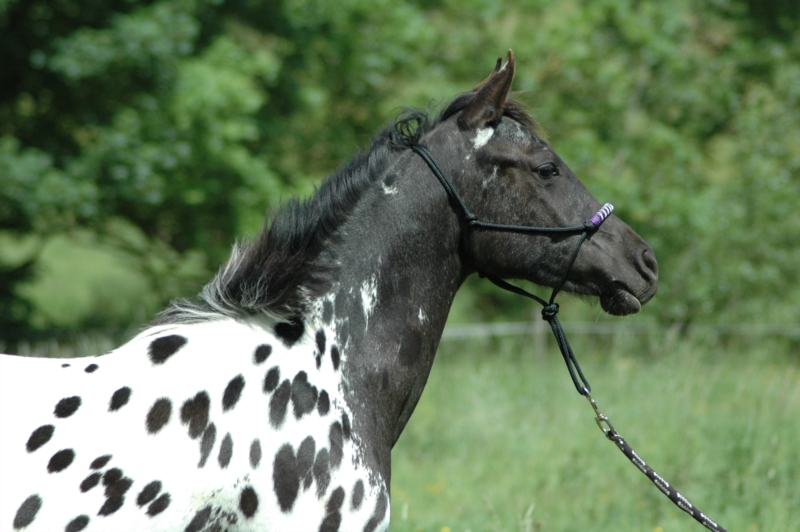The Tiger Horse, or Caballo de Tigre, is a modern gaited horse breed developed from horses with Appaloosa colouring. With their stunning coats, comfortable gaits and friendly natures, it’s easy to see why anyone would want to buy a Tiger Horse. They are not numerous and most breeders who sell a Tiger Horse are based in the USA. The breed is developing, so meeting the standards is still a work in progress.
History and Origins
Spotted horses have a long and interesting history. DNA research has shown that horses with spotted coats existed at least 30,000 years ago. Spotted coat colouring occurs in a number of European horse breeds, such as the Knabstrup and the Noriker. The Varleys, founders of the Tiger Horse breed, believe that this colouring was also known in ancient Siberia and China and was a feature of the horses known as the Heavenly Horses of Central Asia.
They suggest that it was also a feature of some of the early Spanish horses, probably descendants of the Jennet. These, they say, were known as Caballo de Tigre by the Spanish, who used the term “tigre” to include both spotted and striped coat colours in big cats. There are certainly images of spotted Baroque-type horses dating to the seventeenth and eighteenth centuries. The history of the Appaloosa is another important aspect of the spotted horse story, with its links to the Niimíípu people. This tribe cherished the spotted coat colouring in all its varieties and traded their horses widely. In 1994, the Varleys set up the Tiger Horse Association (THA) in America. They were aware that within the Appaloosa breed, horses existed with extremely comfortable gaits, such as the shuffle.
The Tiger Horse is being developed to have the convex facial profile prized in Spanish horses and to be gaited. The aim is to produce a comfortable, colourful horse with features that were admired by many horse-loving cultures. Also, it is intended to recreate the noble spotted type seen in artworks of the past. Horses that exhibit characteristics close to the Tang dynasty horses can gain the Soulon Seal of Approval. Foundation breeds contributing to the Tiger Horse include Appaloosas, Spanish Mustangs and several other Spanish influenced breeds, and Native American herds.
What is a Tiger Horse?
The Tiger Horse is a warm-blooded breed that originated in China. They are known for their courageous character, their extraordinary colours and gaits.
Use and characteristics of the Tiger Horse
Tiger Horses can be between 13 hands (52 inches/132 cm) high and 16 hands (64 inches/163 cm) high. They weigh from 700 to 1500 lb/318 to 682 kg and are classified as a light horse breed. The aim of the creators of the breed, Mark and Victoria Varley, was to produce a type of horse inspired by noble breeds of the past.
The characteristics they selected were a convex or straight profile, curved ears and a lean head with large eyes, set on an arched neck. The horses are sturdy without being over-muscled, with strong legs. Their gaits are comfortable to ride, making them suitable for all members of the family, and they have the spectacular Appaloosa colouring that is greatly admired.

Tiger Horses can be between 13 hands (52 inches/132 cm) high and 16 hands (64 inches/163 cm) high. They weigh from 700 to 1500 lb/318 to 682 kg and are classified as a light horse breed.
Tiger horses in equestrianism
The breed is divided into two basic types; Royal and Heavenly. Their specialisms are the middle gaits. Royalty Horses have the smooth, even 4-beat gait known as the running walk. They can also exhibit the diagonal (fox trot) and lateral (stepping pace) gaits. There is a further gait, named the “Glider Gait” in the standards. This is known elsewhere as “The Indian Shuffle”. Tiger Horses make great riding horses, family horses and working horses.
How many gaits does the Tiger Horse have?
In addition to the three basic gaits, walk, trot and canter, the Tiger Horse has at least one additional gait. However, the horses' gait spectrum is so distinctive that they can have up to 9 gait variations.

